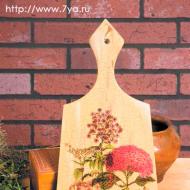
Hazel is multi-leaved. Description of multi-leaved hazel: planting and care
Synonyms: variegated hazel, Corylus heterophylla Fisch. ex Trautv., Siberian hazel.
hazel- a species from the genus Hazel of the Birch family. In culture since 1882. First described in 1834. In nature, it grows in Eastern Siberia (Chita region), Mongolia, China, Russia (Far East), Japan, Korea. It occurs in the undergrowth of oak, black birch, mixed and pine forests, as well as on the edges, burnt areas, clearings, on the slopes of ridges and hills, on the piedmont slopes of plateaus, terraces of river valleys, and plateaus. Forms thickets, often quite dense and impenetrable.
It is a tall shrub 2-4 m in height and a trunk diameter of up to 10 cm. The growth rate is high. At 54, it reaches 3.6 m in height and 330 in diameter. The crown is ovoid or spherical, very dense and wide. Young shoots are glandular, densely pubescent, one-year-old shoots are light brown in color, almost naked, with dissected lenticels. The bark on the trunk is brown or brown-gray. Lives up to 80 years.

It has a shallow root system.

Kidneys ovoid, small, obtuse; scales rounded, ciliated. Leaves are broadly obovate or rounded, 6-10 cm long, 5.5-10 cm wide, weakly heart-shaped at the base and truncated or almost two-lobed at the apex, with a sharp end that usually does not exceed the wide lateral lobes; unevenly doubled-toothed, glabrous and dark green above, pubescent along the veins below and lighter. Petioles with glands, hairy, from 1 to 2.5-3 cm in length. In spring, the leaves are reddish when blooming, in summer they become dark green, in autumn - golden orange, orange, golden yellow. The leaves bloom in early May, turn yellow in September, fall off quickly.

Blooms in the second half of March and until the end of April. Male catkins up to 4 cm long and 4-6 mm thick, pale brown in color, collected 1-5 pieces per peduncle. Female flowers during the flowering period are hidden in buds with exposed crimson stigmas.

Fruits from 9 years. The fruits are collected in 2-3 at the ends of the shoots and grow on a stem up to 3 cm in length. Nuts oblate-spherical shape, up to 1.5 cm in diameter, edible; the shell is very hard, gray-pubescent. The involucre consists of 2 leaflets, dissected into 6-9 toothed, almost identical lobes, bell-shaped, does not completely cover the nut, velvety-pubescent. Nuts ripen in mid-August - September.
Varieties: Corylus heterophylla var. heterophylla, Corylus heterophylla var. sutchuenensis Franch., Corylus heterophylla var. thunbergii Blume
Frost resistance zone: 4 (-45°C).
Location: Shade tolerant. Can grow under tree canopy. In open sunny places it can grow strongly. Prefers rich in humus, fresh soils, but can grow on semi-rocky dry mountain soils, on sandy loamy alluvial loamy soils of forest valleys. Poorly tolerates swamping. Does not require a powerful soil layer.
Landing: The optimal age of the seedling is 2 years. Planting is best done in the fall. The size of the planting pit is 50x60 cm. 10-15 kg of humus, 200 g of superphosphate, 50 g of potassium salt are poured into the pit and mixed with the top layer of fertile soil. Before planting, seedlings must be cut to 20-25 cm, and the roots are dipped in a mash of clay and manure. Distance between plants 4-5 m apart, slightly denser in hedges. For good pollination, it needs several pollinating varieties.
Care: care consists in loosening the trunk circles, but not deep, mulching (for example, mowed grass). During dry periods, watering is recommended.
Pruning: must be carried out in early spring before the start of sap flow. Needs only sanitary pruning.
Reproduction: seed germination 33%. Seeds need stratification within 2-3 months at a temperature of 0 - 5°C. Sowing depth 4-5 cm. Ground germination rate 79 - 86%. The rooting rate of cuttings when treated with a 0.01% IMC solution for 16 hours is 50%.
Pests: hazel leaf beetle, nut weevil, hazel volnyanka, bud mite, rodents.
Diseases: anthracnose, gray and fruit rot.
Usage: used to obtain valuable nuts. With a decorative purpose, it is widely used in forestry and green building, planted in large groups, arrays, on the edges, in single plantings in parks and forest parks.
We sowed or planted most of the plants in the spring and it seems that in the middle of summer we can already relax. But experienced gardeners know that July is the time for planting vegetables for a late harvest and the possibility of longer storage. This also applies to potatoes. Early summer potato crops are best used quickly, they are not suitable for long-term storage. But the second crop of potatoes is exactly what is needed for winter and spring consumption.
Astrakhan tomatoes ripen remarkably lying on the ground, but you should not repeat this experience in the Moscow region. Our tomatoes need support, support, a garter. My neighbors use all sorts of pegs, garters, loops, ready-made plant supports, and mesh fences. Each method of fixing the plant in an upright position has its own advantages and "side effects". I'll tell you how I place tomato bushes on trellises, and what comes of it.
Bulgur with pumpkin is a dish for every day, which is easy to prepare in half an hour. Bulgur is boiled separately, the cooking time depends on the size of the grains - whole and coarse grinding for about 20 minutes, fine grinding for just a few minutes, sometimes the cereal is simply poured with boiling water, like couscous. While the cereal is cooking, prepare the pumpkin in sour cream sauce, and then combine the ingredients. If you replace ghee with vegetable oil, and sour cream with soy cream, then it can be included in the lenten menu.
Flies are a sign of unsanitary conditions and carriers of infectious diseases that are dangerous for both humans and animals. People are constantly looking for ways to get rid of nasty insects. In this article, we will talk about the Zlobny TED brand, which specializes in fly protection products and knows a lot about them. The manufacturer has developed a specialized line of drugs to get rid of flying insects anywhere quickly, safely and without extra costs.
The summer months are the time for hydrangeas to bloom. This beautiful deciduous shrub is luxuriously fragrant with flowers from June to September. Florists willingly use large inflorescences for wedding decors and bouquets. To admire the beauty of a flowering hydrangea bush in your garden, you should take care of the proper conditions for it. Unfortunately, some hydrangeas do not bloom year after year, despite the care and efforts of gardeners. Why this happens, we will tell in the article.
Every summer resident knows that plants need nitrogen, phosphorus and potassium for full development. These are the three main macronutrients, the deficiency of which significantly affects the appearance and yield of plants, and in advanced cases can lead to their death. But at the same time, not everyone understands the importance of other macro- and microelements for plant health. And they are important not only in themselves, but also for the effective absorption of the same nitrogen, phosphorus and potassium.
Garden strawberries, or strawberries, as we used to call them, are one of the early fragrant berries that summer generously endows us with. How we rejoice in this harvest! In order for the "berry boom" to repeat every year, we need to take care of the care of the berry bushes in the summer (after the end of fruiting). The laying of flower buds, from which ovaries will form in spring, and berries in summer, begins approximately 30 days after the end of fruiting.
Spicy pickled watermelon is a savory snack for fatty meat. Watermelons and watermelon rinds have been pickled since time immemorial, but the process is laborious and time consuming. According to my recipe, it’s easy to cook pickled watermelon in 10 minutes, and a spicy snack will be ready by the evening. The watermelon marinated with spices and chili is stored in the refrigerator for several days. Be sure to keep the jar in the refrigerator, not only for the sake of preservation - chilled, this snack is just licking your fingers!
Among the variety of species and hybrids of philodendrons, there are many plants, both gigantic and compact. But not a single species competes in unpretentiousness with the main modest - blushing philodendron. True, his modesty does not concern the appearance of the plant. Reddening stems and cuttings, huge leaves, long shoots, forming, although very large, but also strikingly elegant silhouette, look very elegant. Philodendron blushing requires only one thing - at least minimal care.
Thick Chickpea Soup with Vegetables and Egg is an easy recipe for a hearty first course inspired by Oriental cuisine. Similar thick soups are prepared in India, Morocco, and the countries of Southeast Asia. The tone is set by spices and seasonings - garlic, chili, ginger and a bouquet of spicy spices, which can be assembled to your liking. It is better to fry vegetables and spices in melted butter (ghee) or mix olive oil and butter in a saucepan, this, of course, is not the same, but it tastes similar.
Plum - well, who does not know her ?! She is loved by many gardeners. And all because it has an impressive list of varieties, surprises with excellent harvests, pleases with its variety in terms of ripening and a huge choice of color, shape and taste of fruits. Yes, somewhere she feels better, somewhere worse, but almost no summer resident refuses to grow her on her plot. Today it can be found not only in the south, in the middle lane, but also in the Urals, in Siberia.
Many ornamental and fruit crops, except for drought-resistant ones, suffer from the scorching sun, and conifers in the winter-spring period - from the sun's rays, enhanced by the reflection from the snow. In this article we will talk about a unique preparation for protecting plants from sunburn and drought - Sunshet Agrosuccess. The problem is relevant for most regions of Russia. In February and early March, the sun's rays become more active, and the plants are not yet ready for new conditions.
“Each vegetable has its own time”, and each plant has its own optimal time for planting. Anyone who has experienced planting is well aware that the hot season for planting is spring and autumn. This is due to several factors: in spring, the plants have not yet started to grow rapidly, there is no sweltering heat, and precipitation often falls. However, no matter how hard we try, circumstances often develop in such a way that landings have to be carried out at the very height of summer.
Chili con carne in Spanish means chili with meat. This is a Texan and Mexican dish whose main ingredients are chili peppers and minced beef. In addition to the main products, there are onions, carrots, tomatoes, and beans. This red lentil chili recipe is delicious! The dish is fiery, burning, very satisfying and amazingly tasty! You can cook a large pot, arrange in containers and freeze - a whole week will be a delicious dinner.
Cucumber is one of the most beloved garden crops of our summer residents. However, not all and not always gardeners manage to get a really good harvest. And although growing cucumbers requires regular attention and care, there is a little secret that will significantly increase their yield. It's about pinching cucumbers. Why, how and when to pinch cucumbers, we will tell in the article. An important point in the cultivation of cucumbers is their formation, or type of growth.
Hazel has many species, one of which is hazel variegated. It is also called horned hazel. She got this name due to her leaves, which have an unusual appearance and are somewhat similar to a horn. Diversified hazel is very tasty and healthy. Therefore, amateur gardeners grow it with pleasure. In addition to its unusual taste, the plant also has an appearance unusual for hazel, which allows it to be used as an ornamental shrub.
Hazel is often used as an ornamental shrub.
Also, the composition of this variety includes many useful substances that improve the general condition of the body. A variety of tinctures and preparations are made from this nut.
This species is used by people as often as other varieties of hazel.
Characteristics of hazel
Diversified hazel is a medium-sized shrub. In height, it can reach a maximum of 4 meters. The progenitor is the common hazel. There are different types of hazel, but this one is most similar to hazelnuts.
Young trees of the variety have beautiful lush branches, but the older the bush becomes, the less foliage remains on it. The kidneys are very small and somewhat resemble a quail egg. The leaves are oval and wide, at the tip they have a point that resembles a horn. The length of one sheet can reach 11 centimeters, and a width of 10 centimeters.
The foliage is dark green above and slightly lighter below. Hazel blossoms around April, and the fruits ripen by September. It is worth noting that the heterogeneous hazel has such a feature as the drying of the leaves: on a bush in this state, they can stay until severe frosts.

Nutlets of multi-leaved hazel ripen by September
Planting varieties
Planting hazel variegated can be carried out both in spring and autumn. Before that, you should prepare a place for her. It is advisable to choose one where groundwater is no lower than 1.5 meters. The shrub should be located at a distance of 5 meters from other plants.
Hazel feels great in any soil, except for loamy and swampy. The shrub prefers non-acidic soils or rich in humus.
For autumn planting, seedlings that have at least three good shoots are perfect. Their roots should be about 50 centimeters long. Before planting hazel, the roots should be shortened to 25 centimeters. Landing pits during this period should be prepared in advance. Their depth should be about 50 centimeters, if the soil is fertile.
Before planting, manure and fertilizers are placed in a pit, and then covered with fertile soil and immediately watered. Spring planting is carried out according to the same scheme, but the pit is being prepared in the fall.
You need several plants planted side by side so that they can self-pollinate. It is advisable to use not only multi-leaved hazel, but also other varieties.

For planting, choose well-developed seedlings.
Caring for hazel
Caring for hazel variegated will not take much time and effort. It is recommended to plant lupins or oats next to the shrub. These plants can be used for mulching. The soil near the hazel should be loosened regularly and weeds should be removed near it. It is also worthwhile to clean the overgrowth on time.
Watering
Diversified hazel needs regular watering. The seedling begins to be watered 7 days after planting. If the nut does not have enough moisture, then it will not be able to bloom and bear fruit normally. During the growing season, you need to water the plant about six times. At this time, six buckets of water should be poured onto one bush.
If the summer is too hot, then watering should be done as often as possible, and in the rainy period, reduce it. An adult tree is watered once a week.
top dressing
Variegated hazel needs feeding. In autumn, potassium and phosphorus are used, and top dressing is carried out every three years. In addition to them, you can use manure and superphosphate.
In spring, the plant needs a nitrogen supplement. It can be purchased at any gardening store. Nitrogen must also be applied in early June. This will allow all nuts to ripen equally. For young bushes, it is better to use organic fertilizers.

Superphosphate is suitable for feeding hazel
Bloom care
The flowering of this shrub begins in April. The flowers appear on it before the leaves. When the air temperature rises to 12 ° C, the earrings will begin to actively grow and add about 3 centimeters in growth. This process takes two weeks.
The higher the air temperature, the better male flowers pollinate female ones.
Methods of propagation of hazel hazel
The multi-leaved hazel is propagated in the same way as other varieties of this family. There are several ways that are popular:
- seeds;
- layering;
- vaccination;
- cuttings;
- dividing the bush.
The seed method is most often used in order to obtain a new variety. If you want to get a specific variety of nut, then it is better to resort to vegetative methods. You can use reproduction using layering. To do this, you just need to take young shoots and dig them to the ground.
For grafting as a stock, it is better to take wild hazel or red majestic. Nuts are grafted in summer or spring. It is better to graft a multi-leaved hazel with other varieties for the bark. After that, the seedlings are stored all winter to be planted in the spring.

Wild hazel is optimal as a rootstock
The simplest methods of propagation are dividing the bush and cuttings. The first method is that the bush should simply be dug up and divided into the desired amount. For cuttings, small branches of hazel are prepared. After that, they are planted in closed ground and kept in this state until spring, when they need to be planted in open ground.
The aphid has a dark green color, so it is difficult to identify it on the hazel. It can only be detected over time, when it has already sufficiently affected the plant.
If you find at least one of the above listed insects on a hazel, then you should act immediately. To begin with, it is recommended to spread a film under the plant and shake the shrub. If this does not help, then the plant is treated with special means. Karbofos or Chlorophos is well suited for this.
Spreading
Naturally grows in Eastern Siberia (in the southeastern part of Transbaikalia), in the Far East. In Russia, it is known in culture in different habitats, but it is promising only for green building in the Far East, in Eastern and Western Siberia. Ecologically, it is similar to common hazel. It grows on dry semi-rocky mountain soils, on alluvial loamy and sandy loamy soils of river valleys, but the best for it are fresh, humus-rich soils; does not tolerate swamping, does not require a powerful soil layer, the root system is superficial.
Tree
Shrub with a spherical crown 2 to 4 m high. Young shoots are densely pubescent, later almost naked, light brown with scattered lenticels. The kidneys are obtuse, ovoid, small, with ciliated rounded scales. Buds open in May. The leaves are broadly obovate or rounded, 6–11 cm long and 5–10 cm wide, pith at the base, truncated or almost two-lobed at the apex, with a short apex. The tip does not exceed the lateral lobes. From above, the leaves are dark green and bare, from below they are lighter and lowered along the veins, the petioles are hairy with glands. Male catkins 2–4 cm long, arranged 1–5 per peduncle. Blooms from the second half of March to the end of April. The fruits are collected 2–3 at the ends of branches on a stem up to 3 cm long, the wrapper is velvety, pubescent, from two leaves, bell-shaped. The involucre slightly exceeds the walnut, dissected into 6–9 almost identical toothed lobes. The nut is spherical, flattened from above, about 1.5 cm in diameter. Nuts ripen in September. Propagated by seeds and vegetatively. Hazel is decorative, its nuts are edible, although not better than other types of hazel. Store nuts for more than one winter should not be.
Wood
Reddish-white, uniform in structure, flexible, on the end section, false wide medullary rays are clearly visible. Density at 15% humidity 0.62 g / cm³, at 12% - 0.59 g / cm³.
Drying
Dries well.
Strength
At 12% humidity, the compressive strength along the fibers is 441×10 5 Pa, in static bending - 920×10 5 Pa, in tension - 517×10 5 Pa.
Fortitude
Not resistant.
Technological properties
Well handled. The wood is very flexible and durable.
Application
It is used for the manufacture of bent furniture and products, straight stems - for canes, handles, rods, thin branches - for coarse weaving, sawdust - for clarification of vinegar and purification of cloudy coarse wines. The bark contains 7-8% tannins and dyes. Nuts containing 65% fat, about 16% protein and 3.5% sugar and vitamins are used in the food industry. Flour is extracted from mature nuts, milk is extracted from young ones.
















